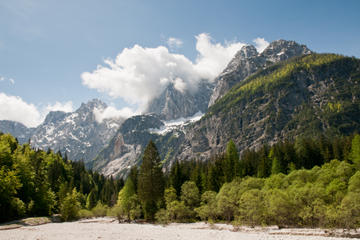
Julian Alps
The highest mountain in Slovenia is Triglav, ascending to 2,864 meters (9,400 feet) in the Julian Alps and forming part of the country’s one and only national park. An alpine region of spectacular natural beauty, Triglav National Park is a landscape of river gorges, waterfalls, lakes, plateaus and cave systems carved out of the limestone bedrock as well as a paradise for fly fishing, hiking, cycling, trekking, skiing and climbing.
The rivers Soča and Sava rise in the Julian Alps and feed the pristine, emerald waters of lakes Bohinj and Bled. The former is Slovenia’s largest lake, swelled by glacier melt and spring waters that race through tumbling gorges on their way down to Lake Bled. Ribcev Laz is Bohinj’s laidback base for cyclists and hikers in the mountains, where rare ibex and golden eagles can occasionally be spotted.
Lake Bled is the summer playground of the Julian Alps, a center for sailing, fishing, kayaking and swimming based around the red roofs of Bled, the photogenic spa town squeezed between the snow-clad peaks and the lake. It is watched over by a ninth-century castle perched atop a rocky crag, while back down on the lake, traditional wooden pletna boats ply to and from the craggy islet home of the Baroque Church of the Assumption. Pretty as a picture, it is one of Slovenia’s most romantic wedding venues.
Winter sees a thick mantle of snow carpet the Julian Alps, when a dozen purpose-built resorts fill up with skiers. Foremost among these are Kranjska Gora, Kobla and Vogel, which all offer over 20 km (12.5 miles) of prepared piste for downhill and cross-country skiers as well as a modern, efficient network of lifts.
Practical Info
The Julian Alps are 2.25 hours northwest of Ljubljana and can be accessed by road or rail. Bled is the main town in the region; its tourist office is at Svobode 10 and it opens Mon–Sat 8am–6pm, Sun 11am–5pm.
